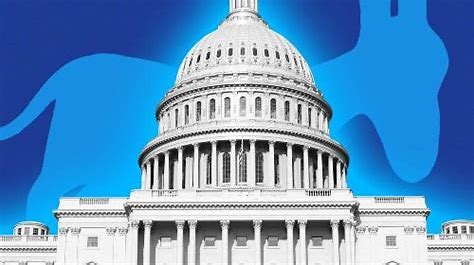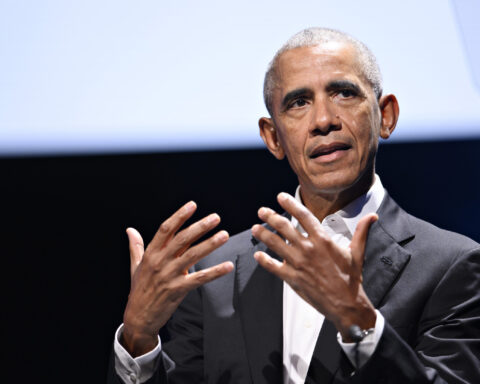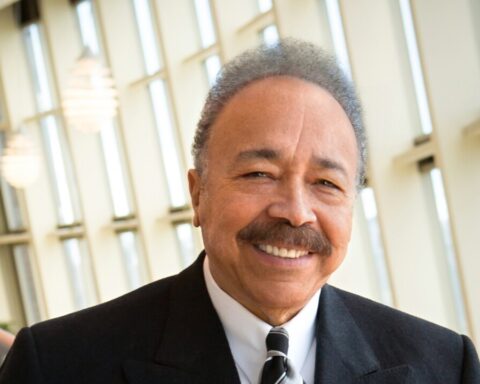The huge voter turnout over the past three elections could scramble the usual dynamics of midterm voting — potentially providing Democrats their best chance to avoid losses next year that could cost them control of the House, the Senate or both.
The president’s party has almost always lost ground in the first midterm after his election, a trend that stretches back well into the 19th century and threatens Democrats clinging to a slim majority in the House and a 50-50 split in the Senate after Joe Biden’s victory in 2020. One reason for those consistent losses, political scientists and campaign operatives agree, has been that voters who support the new president typically have not felt as much urgency to turn out in the midterm elections as the voters opposed to him.
That risk still looms over Democrats, but the party has a unique, rarely discussed, asset in trying to avoid that fate in 2022: the unusually large pool of voters who have backed its candidates in recent elections.
Voters surged to the polls in large numbers in 2016, and in record-breaking proportions in the 2018 and 2020 elections; Democrats won the popular vote in both of those presidential races by substantial margins, while also capturing significantly more House votes nationwide than the GOP in 2018.
As a result, there are nearly 91 million individual Americans who have voted Democratic in at least one of those three elections, according to previously unreported calculations by Michael Podhorzer, the longtime political director of the AFL-CIO, from data collected by Catalist, a Democratic targeting firm. Even with Donald Trump’s formidable success at energizing his supporters, that’s significantly more than the slightly more than 82 million voters who backed Republicans in at least one of the past three elections, according to Podhorzer’s calculations.
This disparity helps explain the torrent of new laws that red state Republicans are passing, on an almost entirely party-line basis, making it more difficult to vote. As I’ve written, those laws, especially across the Sun Belt, represent an effort by local Republicans to stack sandbags against a rising tide of demographic change: to fortify their dominance in those states before a racially diverse rising generation of younger voters potentially erodes their advantage. The large surge of first-time voters in 2018 and 2020 offered Republicans an uncomfortable preview of how that generational replacement may change the electoral balance of power, because Catalist found that new voters in each election, especially the youngest ones, leaned solidly Democratic.
Beyond the changes in state law, other offsetting factors could dilute the potential advantage for Democrats of this unusually large pool of recent voters. Early polling shows Trump’s core supporters already are highly motivated for 2022; young people, who proved essential to Biden’s victory in 2020, historically have turned out at far lower rates for midterm elections; and both the Senate races and House seats that could decide control of those chambers may be fought in states and districts where core Democratic constituencies are less plentiful, especially if congressional Democrats can’t agree on federal legislation to restrict gerrymandering in GOP-controlled states.
John Rogers, who felt the brunt of the Democratic turnout wave as executive director of the National Republican Congressional Committee during the 2018 elections, thinks 2022 will revert closer to the usual midterm pattern, with the party out of the White House exhibiting more enthusiasm about voting. With Trump out of office, he says, Democrats are not displaying anywhere near the grassroots energy and urgency they showed during the years of “the resistance” to his presidency.
“It just feels like a lot of pressure has been let out of the system on the Democratic side,” says Rogers, now a GOP consultant. Meanwhile, he adds, rank-and-file Republicans are almost uniformly hostile to much of Biden’s agenda: “Personally I believe these [Republican] folks are going to show up because I don’t think they like what’s going on in the White House, and the threat of court packing and name any of 50 policy positions that they want to go stop. I think these folks understand … Republicans need to win back the Senate and the House to stop what’s around the corner.”
Taken together, all of these factors underscore why the president’s party has so rarely avoided losses in midterm elections — and why even many Democrats acknowledge the party faces difficult odds of holding the House in particular. But even with all these headwinds, Podhorzer argues, Democrats have a pathway to overcome the historical trends if they can energize enough of their recent supporters, particularly the huge cohort of voters who participated for the first time in 2018 or 2020.
“Everything else is working against Democrats, but this is the first midterm … that a president’s party has had this reservoir of votes hanging over,” he says. “That’s the way Democrats can avoid the usual losses in the midterm: They have the names and addresses” of what could be an unprecedented number of recent voters.
Midterm election patterns
One of the defining characteristics of midterm elections has long been that turnout falls sharply from the previous presidential contest. Historically, Podhorzer notes, only about 40% of eligible voters have participated in midterms over roughly the past five decades.
That pattern held through the early years of this century, with just over 40% of eligible voters showing up for the 2006 and 2010 midterm elections, and only 37% participating in the 2014 vote, according to calculations from Census Bureau data by Michael McDonald, a University of Florida political scientist who studies voter turnout. In each case, turnout in those midterm contests was about 20 percentage points lower than in the presidential race just two years earlier. In the 2006 and 2010 examples, McDonald calculates, that meant about 40 million fewer people voted in the midterm elections than in the presidential races two years before; in 2014, fully 47 million fewer people turned out than just two years earlier.
Compared with the previous presidential contests, turnout falls for all groups in midterm elections. But it has declined most for groups on which Democrats have grown increasingly dependent: young people and voters of color. That pattern proved especially damaging to Democrats in the two midterm elections during Barack Obama’s presidency: the 2010 contest, when Democrats lost control of the House, and the 2014 election, when they lost their majority in the Senate.
In both of those midterms, according to McDonald’s data, turnout among Black voters fell far more from the previous presidential races than turnout among Whites; also, in each contest, turnout among adults aged 18-29 fell by more than half, a far greater decline than among seniors, a solidly Republican constituency over recent decades. As a result, when compared with the previous presidential races, the composition of the electorate in the 2010 and 2014 midterms was somewhat Whiter and considerably older, a deadly combination for Democrats. Catalist, the Democratic targeting firm, has tried to quantify that dynamic: It estimates that voters who participated in 2008 but didn’t show up in 2010 had backed Democrats by 24 percentage points, while those who fell off between 2012 and 2014 had supported the party by a 15-percentage-point margin.
In other words, a huge number of Democratic voters who helped power Obama to his two historic victories stayed home in the midterms that carried Republicans to control of Congress, and functionally ended Obama’s ability to drive his agenda into law.
By the time Obama left office, operatives in both parties were talking openly about a structural advantage for the GOP in midterm elections, given these turnout patterns among non-White and especially younger voters.
Then came 2018.
In 2018, more than 118 million Americans voted, exactly half of the eligible population, according to McDonald’s calculations. That was the highest midterm turnout, as a share of eligible voters, since 1914, before women won the right to vote.
And while the 2018 electorate was still somewhat older than in 2016, the gray shift wasn’t nearly as powerful as in the past, because young adults turned out at twice the level they did in the last midterm, of 2014. Turnout among Blacks and Hispanics also declined much less than in previous midterms, with the result that the White share of the vote actually fell from 2016 to 2018, according to McDonald’s calculations, an unprecedented pattern in recent years. (Another important new dynamic solidified in 2018 when Democrats performed unusually well among White voters with at least four-year college degrees, who have been the most reliable voters in midterm elections; that could benefit the party in 2022 as well.) The turnout wave continued into 2020, with nearly 160 million people voting and turnout among young people and people of color again rising dramatically.
How significant was 2018?
McDonald, like many experts, doubts that turnout in 2022 will match the peak of 2018, an election electrified by the unique passions surrounding Trump. But after the huge turnout in 2020, he is dubious that participation will fall as far as it did in the Obama midterms, which proved so devastating for Democrats. At this early stage, he’s anticipating around 45% of eligible voters may turn out next year, less than in 2018 but considerably more than in most midterms.
Rogers, the Republican consultant, has similar expectations.
“Right now, I am expecting something that is higher than an average midterm,” he told me, though it will “probably not … go all the way up to 2018.”
To Podhorzer, the prospect that participation next year won’t fall as sharply as it did in 2010 or 2014 is key. The large pool of recent Democratic voters, he argues, provides the party an opportunity to avoid repeating the catastrophically severe reductions in turnout among its core constituencies that buried the party in the two midterms during Obama’s presidency.
Because Democratic voters are more geographically concentrated than Republicans — a trend reinforced by the prospect of aggressive Republican gerrymanders before the 2022 election — most analysts believe Democrats need to win about 51-52% of the national popular vote to secure a House majority, Podohorzer notes. That would translate into about 52 million votes if 100 million people vote next year, or as much as 57 million votes if turnout rises to about 110 million.
Either way, Podhorzer argues, Democrats begin with a head start in the race to reach that total. “No matter what the number is, there are more Democrats out there than Republicans who voted” in these recent elections, he says.
Key to realizing that potential advantage, Democrats agree, is motivating the new voters who surged to the polls in 2018 and 2020. Though Trump also mobilized huge numbers of new voters — especially in 2020 — Catalist estimates that Democrats won exactly three-fifths of the roughly 14 million new voters in 2018 and 55% of the roughly 22 million Americans who voted for the first time in 2020. How many of those voters return in 2022 could be the margin between success and failure for Democrats.
“We had a massive turnout in 2020, all these marginal voters who had not voted before,” says Meg Schwenzfeier, chief analytics officer at Catalist. “So the degree to which they stay in the electorate is the big question for me.”
One recent national survey by veteran Democratic pollster Stanley B. Greenberg for his group Democracy Corps offered sobering results for Democrats on that front. It found the usual midterm pattern firmly in force, with Republican voters — especially evangelical Christians and other conservatives who define themselves as Trump loyalists — expressing much more interest in the election than Democrats, with the falloff in attention particularly severe among young people.
“We were also surprised by how much Donald Trump’s loyalist party is totally consolidated at this early point in its 2022 voting and how engaged it is,” he wrote in a memo detailing the poll. “There is no escaping the reality that Trump’s Republican Party is a self-consciously and self-confidently anti-democratic, anti-immigrant party that will battle for the future of white people in a multicultural America.”
Trump’s effect on 2022 turnout
In an interview, Greenberg said he was not yet convinced that elevated engagement among Trump supporters would translate into high turnout, because the former President has raised so many doubts about the reliability of the electoral system.
“We may be in a situation where one party is in the election cycle and another party may be in an insurrection cycle,” Greenberg says. In focus groups, he notes, many Trump loyalists said no when asked if they planned to become more involved in politics. While those voters have accepted Trump’s unfounded claims that the 2020 election was stolen, he says, “the question is, is it translating into registration and voting, or is their level of interest high with regard to the finishing of the last election?”
McDonald also believes Trump’s ultimate visibility will be critical in determining how many of the casual and first-time voters from the past three elections show up again in 2022 — on both sides.
“My feeling is it really depends on how much Trump overshadows the 2022 election,” he says. “He was a driving force for people who felt passionately about him both ways. … How much of a factor is he going to play in 2022?”
The dominant early view among most Democrats — and certainly in the White House — is to focus far less on Trump in their messaging than on making a case to voters that the party has delivered on their kitchen table concerns by taming the coronavirus outbreak and restarting the economy.
“I think the most important thing” to generate turnout for 2022, says Greenberg, expressing the consensus perspective, “is delivering to those Democrats who are still struggling.”
Some Democratic strategists, however, consider economic gains necessary but not sufficient for the party to defy the usual midterm trends. Consultant Dan Sena, a former executive director of the Democratic Congressional Campaign Committee, for instance, notes that Republicans put money into many voters’ pockets with their 2017 tax cuts but still were routed in the next midterms, even among many affluent suburban voters who had benefited.
“It is a similar situation,” he says. “The emotional and cultural issues are going to drive an awful lot of turnout for the party bases.”
Republicans may inadvertently help Democrats energize their base by openly discussing the possibility they could name Trump the speaker if they recapture the House majority next year. But mostly Biden has been dampening the sense of threat among Democrats, by focusing far more on displaying his willingness to work with Republicans than on portraying them as either an impediment (through their repeated use of the Senate filibuster to block Democratic ideas) or a danger to small-d democracy (through the wave of restrictive voting measures in the states and their resistance to any new federal voting standards).
Biden so far is wagering that Democrats will be rewarded more for cooperation than confrontation, a strategy that was common in an earlier era when strategists believed persuadable swing voters were the key to electoral success, especially in midterm elections, when far fewer people voted than in the presidential races. Now, though, strategists on both sides tend to believe turning out the base is a more decisive factor, even in midterms.
And that means if Biden’s mostly conciliatory approach toward the GOP fails to activate the huge pool of Democratic voters from the past three elections, his party could pay a punishing price in 2022.







